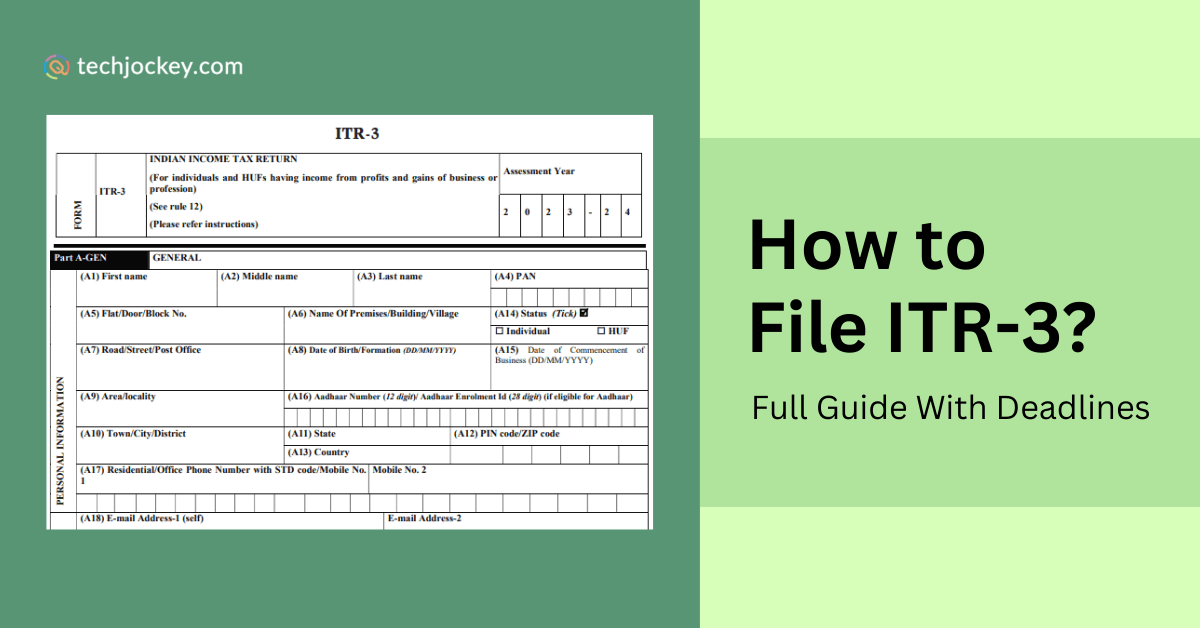
Income tax filing may be daunting, particularly when you earn money through a business or profession, as there are many schedules to consider. But with proper guidance, it is possible to file ITR in less time. As there are many different types of ITR forms for different categories of income, this blog will discuss how to file ITR-3 in detail.
If you want to explore ITR-3 in more detail, you can check out our dedicated blog on “What is ITR-3”.
Here’s what we will discuss:
Structure of ITR-3 form
Step-by-step process including filling out the form, preparing the balance sheet, and handling nil returns
ITR-3 filing deadlines and more
Let’s go.
ITR-3 is relatively comprehensive and is targeted at individuals and HUFs whose income is earned through business or profession. The form is divided into several sections and schedules, which include a general section, balance sheets, profit and loss reports, deductions, and tax calculations.
Part A – General and Financial Statements
Income Schedules
Depreciation and Related Computations
Set-off and Carry Forward of Losses
GEN Income Tax
Starting Price
₹ 3500.00 excl. GST
Deductions under Income Tax Act
Minimum Tax and Tax Credits
Special Income and Disclosures
Final Computation and Verification
Before moving forward to how to file ITR-3, below are the documents that you need to keep ready:
Before you start filing ITR-3, you have to choose between the online and offline modes. For online mode, you can file it through the Income Tax e-Filing portal. And for filing it offline, you have to use the Excel utility available for ITR-1 to ITR-4 for AY 2025-26, which was released in mid-2025. In this blog, we will discuss how to file an income tax return, ITR-3 online.
You can file ITR online either through the Government portal directly or using an income tax software. Here is a detailed step-by-step guide on how to file an income tax return-3 via the Government portal:
Step 1: Go to the official Income Tax e-Filing portal. Log in by entering your PAN as the user ID and password.
Step 2: Go to the “e-File” section. Then, go to Income Tax Returns > File Income Tax Return. Choose the applicable Assessment Year and click on Online mode.
Step 3: Select taxpayer status as Individual or HUF.
Step 4: Now, select the ITR-3 form. You can import pre-filled data or JSON offline utility, or download draft ITR files to begin.
Step 5: Click on “Let’s Get Started” and choose the reason for ITR-3 filing.
ClearTax Income Tax
Starting Price
Price on Request
Step 7: Now, verify your pre-filled personal details and choose your tax regime from Old or New. If you are opting out of the new regime, you need to submit Form 10-IEA.
Step 8: Now fill in personal, business, and income details, which include audit details if applicable.
Step 9: Enter information into various schedules:
Schedule BP (business income), Schedule CG (capital gains), and others like Schedule AL (assets/liabilities if income > ₹1 crore).
Claim deductions under Chapter VI-A, and input TDS/income data – including Form 26AS and AIS for verification.
System auto-calculates total income and tax liability.
Step 9: Review the form ITR-3 for any errors and correct them if needed. Pay any self-assessment tax (if due). Click on the button “Proceed to Verification” and submit your return.
Step 10: E-verify your ITR-3 instantly via Aadhaar OTP, net banking, EVC, or DSC.
Note: If you are not verifying the ITR-3 form online, then you can send the signed ITR-V to CPC, Bengaluru, within 30 days.
The due date to file ITR-3 for FY 2025-26 is 31st July 2026 for taxpayers having income from business or profession. However, if their accounts require an audit, the deadline is extended to 31st October 2026. Filing ITR-3 on time helps avoid penalties, interest on tax dues, and ensures smooth processing of refunds. Timely compliance also safeguards against future legal or financial complications.
Conclusion
ITR-3 filing could seem tough for those who are not experts at filing it. But with the correct approach and the above step-by-step guide, it is far simpler.
You just need to know the form structure and have all the necessary documentation.
An early filing will guarantee you both compliance and zero penalties. By keeping yourself updated with changes, dates, and appropriate documentation, the ITR-3 filing is less stressful.
The ITR-3 filing due date is 15 September 2025 for the financial year 2024-2025 for non-audit cases. For those who require an audit, the due date is 31 October 2025.
You need to provide details of assets, liabilities, and capital as of 31st March of the financial year, along with profit and loss figures, based on your business or professional books.
Even if you have no taxable income, you can file a nil return by selecting ITR-3, filling basic details, and submitting the form without entering income figures.
When you begin your building information modeling journey, selecting the right software is crucial. Your… Read More
Highlights: The Digital Personal Data Protection Act, India, 2023 is the first comprehensive law in… Read More
Smart technology assists us in our daily lives, and it is operating silently in the… Read More
The holiday season is all about cozy lights, warm emotions, and picture-perfect memories and now,… Read More
Android trojan, for the unversed, is malware that poses a serious threat to mobile… Read More
Smartphones have completely transformed how we bank, making money transfers and payments quicker and more… Read More